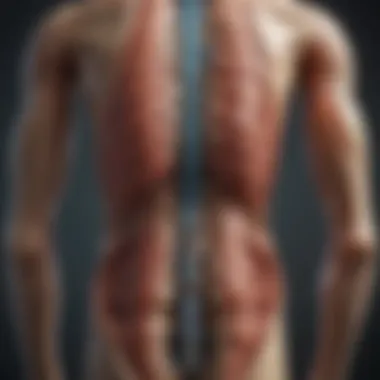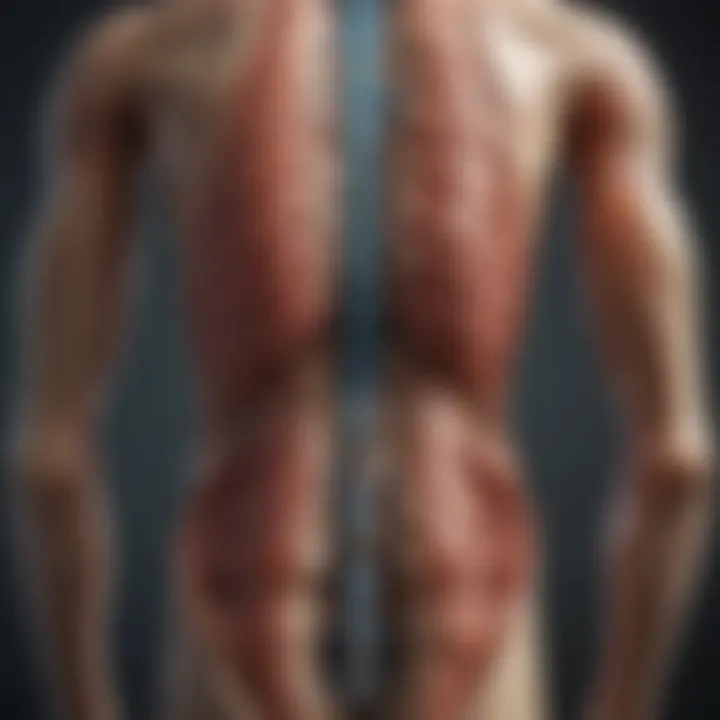Exploring the Essential Functions of the Spinal Cord


Intro
The spinal cord plays a vital role in the central nervous system, serving as a conduit for communication between the brain and the rest of the body. A strong grasp of its functions is fundamental for students, researchers, educators, and professionals within various fields of health and science. Understanding how the spinal cord operates, its structural organization, and its role in reflex actions can enhance comprehension of human physiology and neurological health.
In addition to basic functions, the spinal cord’s response to injuries and the ongoing innovations in medical therapy are critical topics of study. This article aims to unravel these complexities, providing an in-depth exploration of the spinal cord and its significance within the broader context of health and science.
Recent Advances
Latest Discoveries
Recent research has provided new insights into the spinal cord's plasticity and its ability to adapt following injury. Scientists have discovered that certain neural pathways can regenerate, which opens possibilities for recovery after spinal cord damage.
A notable study published in reputable neurological journals highlighted that adult spinal cord cells exhibit more regenerative capability than previously thought. These findings will require further studies to clarify the mechanisms involved, yet the implications for treatment are promising.
Technological Innovations
Technological advancements also contribute significantly to our understanding and treatment of spinal cord issues. For instance, the development of neuroprosthetics has offered new hope for individuals with impaired mobility. Neuroprosthetics are devices that can restore movement by electronically stimulating nerves, showcasing the potential of technology to aid rehabilitation.
Additionally, medical imaging techniques like functional magnetic resonance imaging (fMRI) and diffusion tensor imaging (DTI) are assisting researchers in visualizing neural pathways across the spinal cord in real-time. These innovations have enhanced our understanding of how spinal injuries affect motor skills and sensory reception.
"The ability of neural pathways to regenerate opens new doors for rehabilitation strategies that were previously unimaginable".
Methodology
Research Design
To understand the complex dynamics of the spinal cord, researchers often employ various research designs, including longitudinal studies and case control studies. By tracking spinal cord responses over time, researchers can analyze changes and correlations that emerge in individuals post-injury.
Data Collection Techniques
Techniques such as electroencephalography (EEG) and electromyography (EMG) allow for the gathering of electrophysiological data regarding spinal cord activity. This information aids scientists in mapping nerve conduction and assessing the viability of treatment options.
Additionally, surveys and questionnaires help capture patient experiences and subjective outcomes during rehabilitation processes, which are invaluable for future studies and clinical practices.
Prelude to the Spinal Cord
The spinal cord plays a vital role in the human nervous system, acting as the primary conduit for signals between the brain and the body. As we explore this topic, it becomes evident that understanding the spinal cord’s functions can illuminate how our bodies interact with environmental stimuli, regulate automatic processes, and execute voluntary movements. This article presents an in-depth examination of the spinal cord’s anatomy and functions, aiming to provide a robust framework for students, researchers, and professionals interested in neurobiology and related fields.
Definition and Overview
The spinal cord is a long, cylindrical structure encased within the vertebral column, extending from the brainstem to the lower back. It consists of millions of nerve fibers that facilitate communication between the brain and peripheral nervous system. The spinal cord is segmented into multiple regions, corresponding to the vertebrae: cervical, thoracic, lumbar, and sacral. Each segment is responsible for specific bodily functions, integrating sensory input and coordinating responses.
Its structure is essential in maintaining reflex actions and motor control, and it also serves as a central hub for processing sensory information.
Importance in the Nervous System
The spinal cord's significance in the nervous system cannot be overstated. It connects various parts of the body with the brain, ensuring proper communication for movement and sensory understanding.
Consider the following key points about its importance:
- Signal Transmission: The spinal cord effectively transmits signals to and from the brain, affecting everything from muscle contractions to the perception of pain.
- Reflex Actions: Reflexes are processed through the spinal cord, allowing for rapid reactions without involving the brain. For instance, if you touch something hot, the reflex arc that results in withdrawal occurs almost instantaneously.
- Homeostatic Function: The spinal cord also plays a role in regulating autonomic functions like heart rate and digestion, thus contributing to overall homeostasis.
"The spinal cord is not just a pathway; it is a complex and adaptable structure essential for survival and interaction with our environment."
Understanding these aspects is foundational for analyzing the functional complexities of the spinal cord. An appreciation of its intrinsic role lays the groundwork for further exploration into its anatomy, circuitry, and implications in neurological health.
Anatomical Structure of the Spinal Cord
The anatomical structure of the spinal cord is fundamental to understanding its diverse functions. This structure serves as the backbone for the central nervous system. It allows for efficient communication between the brain and peripheral nervous system. By comprehending the alignment and organization of the spinal cord, one can better appreciate how various regions contribute to motor control, sensory processing, and reflex activities.
Regions of the Spinal Cord
Each region of the spinal cord has unique features and responsibilities. Grasping these nuances can enhance the understanding of how the spinal cord operates as an integrated unit within the nervous system. The four main regions include: cervical, thoracic, lumbar, and sacral.
Cervical Region
The cervical region occupies the uppermost part of the spinal cord, consisting of eight pairs of spinal nerves. This region is essential for controlling neck, shoulder, and arm movements. Notably, the cervical plexus provides sensory input to the head while enabling motor functions to the shoulder and diaphragm. A significant feature of the cervical region is its ability to transmit signals quickly due to its shorter pathways. This is beneficial for rapid reflex actions and coordinated voluntary movements in the upper body.
Thoracic Region
The thoracic region consists of twelve pairs of spinal nerves. It connects to the torso and plays a vital role in providing stability to the upper body. A key characteristic of the thoracic region is its attachment to the ribs. This anatomical relationship enables coordination between spinal functions and respiratory movements. The thoracic spinal cord also aids in coordinating signals for the upper limbs, enhancing overall motor control.
Lumbar Region


The lumbar region is comprised of five pairs of spinal nerves, located below the thoracic area. This region is crucial for the control of leg movements and pelvic sensations. The lumbar region has a larger cross-sectional area compared to other sections. This feature supports a higher number of motor neurons, making it pivotal for leg locomotion. Furthermore, injuries to this section can significantly affect mobility due to its role in lower body function.
Sacral Region
The sacral region contains five pairs of spinal nerves and lies just below the lumbar region. It is fundamental in controlling pelvic organs and lower limbs. A distinctive aspect of the sacral region is its close relationship with the autonomic nervous system. This connection allows for reflex actions related to bladder and bowel control. While often overlooked, its importance is considerable, particularly for maintaining bodily autonomy in reflexes.
Meninges and Spinal Fluid
The meninges are protective membranes surrounding the spinal cord. They play a crucial role in safeguarding against injury and infection. The three layers of meninges include the dura mater, arachnoid mater, and pia mater. Cerebrospinal fluid circulates in the space between these layers, serving several functions: it cushions the spinal cord, provides nutrients, and removes waste products. Understanding the interplay between the meninges and spinal fluid highlights the importance of protection in the central nervous system's overall function.
Neuronal Composition and Functioning
The spinal cord's functionality relies heavily on its neuronal composition. Neurons are specialized cells that form the basic building blocks of the nervous system. They play various roles in signal transmission, muscle activation, and sensory processing. Understanding these elements provides insights into how the spinal cord contributes to bodily functions and neural health.
Types of Neurons
Sensory Neurons
Sensory neurons have a vital role in relaying information from the body to the spinal cord and brain. These neurons are responsible for carrying signals related to touch, pain, temperature, and other sensory modalities. A key characteristic of sensory neurons is their structure, which typically includes long dendrites that can detect stimuli. This makes them well-suited for gathering information from the environment and sending it to the central nervous system.
One unique feature of sensory neurons is their ability to adapt to various stimuli. This adaptability allows for a wide range of sensory experiences. However, this characteristic can also lead to issues such as sensory overload, where too many stimuli may lead to confusion in signal processing. Despite this potential drawback, sensory neurons remain essential for accurate environmental perception and survival.
Motor Neurons
Motor neurons are crucial for initiating and controlling muscle movements. They convey impulses from the spinal cord to muscles, leading to voluntary and involuntary actions. A defining characteristic of motor neurons is their long axons, which make them effective in communicating signals over distances to various muscle groups.
The unique aspect of motor neurons is the type of neurotransmitters they release at the neuromuscular junction, primarily acetylcholine. This neurotransmitter facilitates muscle contraction, ensuring coordinated movement. One challenge associated with motor neurons is their vulnerability to injury and disease, such as amyotrophic lateral sclerosis (ALS). Despite this risk, their function is vital for mobility and daily activities.
Interneurons
Interneurons serve as intermediaries between sensory and motor neurons within the spinal cord. These neurons facilitate complex reflex arcs and processing of information. A key feature of interneurons is their abundance; they outnumber both sensory and motor neurons combined. This high quantity allows for intricate processing and integration of sensory inputs before sending out motor responses.
Interneurons can be excitatory or inhibitory, adding flexibility to how signals are processed. One advantage is their ability to modulate reflexes and response patterns, allowing for adaptive behaviors. However, the complexity of interneuron circuits can also lead to challenges in understanding certain neurological disorders. Overall, interneurons play a significant role in coordinating the nervous system's responses to stimuli.
Spinal Cord Circuitry
The circuitry of the spinal cord is what enables it to process and transmit signals effectively. It consists of various pathways and neural connections that allow for reflexive actions and voluntary movement. These pathways include ascending tracts that carry sensory information to the brain and descending tracts that transmit motor commands from the brain to the body.
Understanding spinal cord circuitry is critical for recognizing how different neuron types interact and how information is processed. The interplay between sensory and motor pathways is essential for maintaining balance, posture, and overall coordination. Additionally, the structure of these circuits has implications for recovery from injuries, highlighting the need for advances in research aimed at restoring function.
Signal Transmission and Processing
Signal transmission and processing are crucial elements of the spinal cord's functions. These processes enable the spinal cord to serve as a critical communication link between the brain and the body. Understanding these mechanisms provides insight into how signals are conveyed, processed, and transformed into responses. This section will dissect both ascending and descending pathways, shedding light on their roles in motor and sensory functions.
Ascending Pathways
Dorsal Columns
The dorsal columns are notable ascending pathways that are pivotal for transmitting fine touch, vibration, and proprioceptive information to the brain. This pathway is characterized by its ability to carry detailed sensory information without losing clarity. The dorsal columns rely on large myelinated fibers, which enhance signal speed and fidelity. Their role in spatial awareness and object discrimination makes them invaluable for daily activities.
A unique feature of the dorsal columns is their decussation, where fibers cross over to the opposite side at the level of the medulla before reaching the thalamus. This characteristic allows for efficient integration of sensory information, making the dorsal columns a preferred model for studies on sensory processing within the spinal cord.
However, this pathway's reliance on myelinated fibers means that it may be vulnerable to injuries that affect the myelin sheath. For instance, conditions such as multiple sclerosis can impair its function, leading to sensory deficits.
Spinothalamic Tract
The spinothalamic tract is another essential ascending pathway responsible for conveying pain and temperature sensations. This tract is distinguished by its direct relay of sensory information from the periphery to the brain, primarily via unmyelinated and small myelinated fibers. The spinothalamic tract's rapid transmission is essential for reflexive responses to harmful stimuli, enhancing survival.
A key characteristic of the spinothalamic tract is its somatotopic organization, allowing for a clearly defined mapping of the body's surface to specific brain regions. This feature makes it a widely studied subject in neuroanatomy, underscoring how the body perceives pain and temperature.
The inherent disadvantage of this pathway arises from its less precise nature compared to the dorsal columns. Information about touch and fine discrimination may be less distinct, leading to challenges in identifying the exact location of painful stimuli.
Descending Pathways
Corticospinal Tract
The corticospinal tract is critical for voluntary movement control. This major descending pathway originates in the motor cortex and travels through the brainstem and spinal cord, facilitating motor functions by directly influencing lower motor neurons. A defining feature of this tract is its direct projection to spinal motoneurons, which grants it substantial control over skeletal movements.
This pathway is particularly beneficial since it enables fine motor control, essential for tasks requiring precision, such as writing. Its unique feature is the crossover of axons in the medullary pyramids, allowing for control over contralateral limbs.
However, damage to the corticospinal tract can lead to significant motor impairment, demonstrating the importance of its integrity for executing voluntary movements.
Extrapyramidal Tracts
The extrapyramidal tracts are a collection of descending pathways that play a vital role in coordination and posture. Unlike the corticospinal tract, these pathways do not travel through the medullary pyramids. Instead, they utilize several brainstem nuclei, influencing muscle tone and reflexive movements.


A key characteristic of the extrapyramidal tracts is their involvement in involuntary motor control, which distinguishes them from other pathways that focus primarily on voluntary actions. This aspect makes them essential for refining movement and maintaining stability during complex tasks, such as walking.
The downside of extrapyramidal pathways lies in their potential to contribute to movement disorders when dysregulated. Conditions like Parkinson's disease highlight the challenges associated with these tracts, as they affect smoothness of movements and posture stability.
Understanding the intricacies of spinal cord signal transmission and processing allows researchers and clinicians to devise better interventions for neurological disorders.
Reflex Actions
Reflex actions are fundamental to the functioning of the spinal cord. They are involuntary and immediate responses to certain stimuli, serving as protective mechanisms and essential tools for maintaining homeostasis. Reflexes can occur without the need for conscious thought, thus ensuring a rapid response to potential threats. Understanding reflex actions is crucial for grasping the spinal cord's role in both sensory and motor pathways.
Definition of Reflexes
A reflex is defined as a automatic response to a stimulus that is often subconscious. This quick reaction is facilitated by the spinal cord and occurs via pathways known as reflex arcs. Reflexes bypass the brain for immediate effect, which is vital in situations where speed is critical, such as withdrawing a hand from a hot surface. This capability makes reflex actions crucial for survival and daily functioning.
Types of Reflexes
Reflexes can be categorized into distinct types, two of which are notably important: somatic and autonomic reflexes. Understanding these differences aids in comprehending how various reflex mechanisms operate within the body.
Somatic Reflexes
Somatic reflexes involve skeletal muscles and are directly under our control. One specific aspect of somatic reflexes is the knee-jerk reflex, often tested in medical examinations. This reflex is acknowledged for its simplicity and speed. The key characteristic of somatic reflexes is their role in protecting muscles and joints from excessive strain.
This type of reflex is a beneficial topic for this article as it illustrates how the body maintains stability and protects itself during unexpected movements. The unique feature of somatic reflexes is that they allow for immediate physical responses without requiring decision-making by the brain.
Additionally, somatic reflexes contribute to motor control and coordination, ensuring that the body can respond promptly to external changes. However, they can lead to overreactions, which might result in injury in certain situations.
Autonomic Reflexes
Autonomic reflexes, on the other hand, govern visceral activities and are crucial for regulating internal bodily functions. One specific aspect of autonomic reflexes is the heart rate regulation during stress situations. This aspect underscores the role of the autonomic nervous system in managing bodily functions without conscious awareness.
The key characteristic of autonomic reflexes is their involvement in maintaining homeostasis, making it a popular choice for this article. The unique feature they present is the dual control they offer, balancing activities like digestion and respiratory rate.
One advantage of autonomic reflexes is their innate ability to sustain life-supporting functions even when an individual is not actively aware of it. However, they can lead to dysfunction, such as in cases of autonomic neuropathy, which highlight the delicate balance the body must maintain.
Reflex Arc Components
The reflex arc is the neural pathway taken by reflex signals. It consists of several components:
- Receptor: Detects the stimulus and converts it to an electrical impulse.
- Sensory neuron: Carries the impulse from the receptor to the spinal cord.
- Integration center: Usually located in the spinal cord, processes information and coordinates a response.
- Motor neuron: Transmits the response from the spinal cord to the effector.
- Effector: The muscle or gland that carries out the response.
Understanding these components is crucial for appreciating how reflex actions can happen swiftly and effectively. The efficiency of this pathway highlights the spinal cord's essential role in facilitating rapid reflex actions.
Reflex actions showcase the efficiency of the nervous system, allowing for immediate responses that are crucial for survival and functionality.
By thoroughly examining reflex actions and their mechanics, we can grasp how the spinal cord influences both immediate reactions and long-term bodily coordination.
The Role of the Spinal Cord in Motor Control
The spinal cord plays a vital role in motor control, serving as a bridge between the brain and the muscles. It is essential for executing voluntary movements and maintaining balance, which are fundamental functions for daily activities. Understanding this aspect helps illuminate how spinal cord health directly affects a person’s physical capabilities.
Voluntary Movement
Voluntary movement is the process whereby individuals consciously undertake an action. This type of movement involves a complex pathway that initiates in the brain and passes through the spinal cord. Motor commands originated in the motor cortex send signals down the corticospinal tract, a vital descending pathway. Once these signals reach the spinal cord, they integrate with lower motor neurons to stimulate muscle contractions, resulting in movement.
Key Points about Voluntary Movement:
- Initiation occurs in the motor cortex.
- Signals travel through the corticospinal tract.
- Lower motor neurons in the spinal cord play a critical role.
Voluntary activity also includes a feedback mechanism. When movements are executed, sensory neurons send information back to the spinal cord about muscle position and tension. This feedback enables fine-tuning of motor commands, making movements more coordinated. Conditions that interrupt this system can lead to issues such as paralysis or spasticity. Thus, task-specific training and rehabilitation focus on restoring these pathways to recover voluntary movements effectively.
Posture and Balance
Posture and balance are closely tied to the functions of the spinal cord. The spinal cord helps coordinate postural adjustments through reflex actions and integration of sensory inputs. The body constantly monitors its position in space, with messages relayed from the proprioceptors to the spinal cord. These messages help in adjusting muscle tone and maintaining stability.
Components Involved in Posture and Balance:
- Proprioceptors relay information about body position.
- Sensory inputs from the vestibular system contribute to balance.
- Reflex arcs help make rapid adjustments.
The spinal cord receives input from both the vestibular apparatus in the inner ear and visual systems, which are essential for achieving balance. If a person begins to stumble, the reflex arcs in the spinal cord can trigger immediate muscle contractions to stabilize the body.
"The spinal cord integrates diverse sensory inputs to preserve balance and support posture, underscoring its importance in physical function."
Proper function of these mechanisms is vital for activities ranging from walking to standing still. Injury to the spinal cord can disrupt these processes, leading to unsteady movements and an increased risk of falls. This highlights the significance of spinal cord health in maintaining posture and balance throughout daily life.
Sensory Functionality of the Spinal Cord


The sensory functionality of the spinal cord plays a vital role in how we perceive and respond to the environment. This section examines the pathways through which sensory information travels and how the spinal cord integrates and processes these signals. Understanding this functionality is crucial for both clinical applications and neurological research. By understanding sensory processes, stakeholders might enhance treatment for various conditions, ranging from chronic pain to spinal cord injuries.
Sensory Inputs from the Body
Sensory inputs come from various receptors located throughout the body. These receptors detect different types of stimuli, such as touch, pain, temperature, and proprioception, which is the sense of body position. Sensory neurons carry these signals from peripheral receptors to the spinal cord. This direct connection is essential because it allows for swift reflex actions and the initiation of appropriate responses before the brain even processes the information.
Common sensory receptors include:
- Mechanoreceptors: Detect pressure and touch.
- Thermoreceptors: Sense changes in temperature.
- Nociceptors: Respond to pain stimuli.
- Proprioceptors: Relay information about body position.
As sensory information travels via the dorsal roots of the spinal nerves, it enters at various spinal cord levels based on where the stimulus occurred. This anatomical organization ensures a rapid response, particularly in emergency situations, where speed is critical.
Integration of Sensory Information
Once sensory inputs arrive at the spinal cord, the integration of this information occurs. The spinal cord does not merely relay messages; it interprets the data to some extent. This occurs through networks of interneurons, which are specialized neurons that connect sensory and motor pathways within the spinal cord.
Integration works by:
- Processing multiple inputs at once, allowing for a refined response to complex stimuli.
- Modulating pain through pathways, which includes inhibiting or facilitating pain signals based on context.
- Involvement in reflex actions, where a quick response is required without the need for brain involvement.
Key Insight: The spinal cord serves as both a transmitter and an integrator of sensory information, making it crucial for immediate reactions and overall bodily responsiveness.
Impact of Spinal Cord Injuries
Spinal cord injuries are significant not only because of their direct effects on the body but also due to their profound implications on quality of life. Understanding the extent of these injuries is crucial for developing effective treatments and rehabilitation strategies. Spinal cord injuries can arise from various incidents, including trauma from accidents, falls, and diseases. The importance of this topic resonates in its ability to shed light on the consequences these injuries impose on physical and neurological functions.
Types of Spinal Cord Injuries
Spinal cord injuries can be classified primarily into two categories: complete and incomplete injuries.
- Complete injuries result in a total loss of sensory and motor function below the level of injury. In these cases, there is no preserved function in the sacral segments of the spinal cord. This total loss can lead to severe disabilities.
- Incomplete injuries, on the other hand, allow for some degree of preserved function below the injury site. This can mean varying levels of mobility or residual sensory capabilities, which might significantly influence rehabilitation outcomes.
Consequences on Functionality
Spinal cord injuries induce diverse consequences that affect both motor and sensory functions. Understanding these impacts is essential for grasping the overall implications of such injuries on an individual's daily life.
Motor Impairments
Motor impairments are among the most significant consequences of spinal cord injuries. They refer to reduced or lost ability to control muscle movements. This aspect is critical in understanding mobilization strategies and rehabilitation programs after such injuries.
A distinguishing characteristic of motor impairments is the degree of paralysis. This can range from partial weakness to complete paralysis of limbs. Such variability does not only present challenges in physical therapy but also influences mental health, as individuals must navigate a new reality.
The unique feature of motor impairments is their potential for recovery; some individuals experience significant improvements over time with appropriate interventions. However, the challenge lies in identifying suitable therapy methods that cater to individual needs. This adaptability in treatment is particularly beneficial as it combines both physical and psychological rehabilitation.
Sensory Loss
Sensory loss also substantially impacts individuals with spinal cord injuries. It refers to the diminished ability to feel sensations, such as touch, pain, or temperature, below the injury level. This condition can drastically affect daily living and interactions with the environment.
The key characteristic of sensory loss is its unpredictability; not all individuals will experience the same level or type of loss. This variability makes it essential for healthcare providers to customize assessments and interventions tailored to each person.
Moreover, the unique feature of sensory loss is that it can lead to complications such as pressure sores or injuries, as individuals might not be aware of harm to areas of their body. This progression can create further challenges in managing care post-injury.
Current Advances in Spinal Cord Research
The field of spinal cord research is progressing rapidly, showcasing innovative approaches to address various spinal cord pathologies. Understanding these advancements is critical for improving patient outcomes and developing effective treatments. This section explores regenerative medicine and technological innovations, which play significant roles in enhancing the recovery prospects for individuals suffering from spinal cord injuries.
Regenerative Medicine Approaches
Regenerative medicine represents a pivotal frontier in spinal cord research. It focuses on repairing and regenerating damaged tissues. Novel techniques are being developed to spur healing and functionality, which can profoundly transform lives.
- Stem Cell Therapy: One of the most promising approaches involves the use of stem cells. These cells have the potential to differentiate into various types of nerve cells, offering hope for restoring lost functions. Research shows that transplanted stem cells can aid in the repair of spinal cord injuries, potentially leading to improved motor and sensory functions.
- Biomaterials and Scaffolds: Researchers are also examining the use of biomaterials as scaffolds to bridge damaged sections of the spinal cord. These materials can guide the regrowth of nerve fibers, creating pathways for re-establishing connections between nerves and muscles.
- Neurotrophic Factors: Another exciting avenue includes the application of neurotrophic factors, which support the survival and growth of neurons. Administering these factors can promote regeneration and functional recovery.
- Combination Therapies: Recent studies suggest combining different regenerative techniques may yield better results. For instance, using stem cells alongside neurotrophic factors can amplify the healing process.
These approaches not only augment the potential for recovery but also challenge the traditional understanding of nerve injury management.
Technological Innovations
Technological innovations have also heralded a new era in spinal cord research, providing tools and methods that enhance both the understanding and treatment of spinal issues. Some notable innovations include:
- Neuroprosthetics: These devices interface with the nervous system, restoring some motor functions in individuals with paralysis. Advances in neuroprosthetic technology allow users to control limbs through brain signals, which has shown promising results in clinical trials.
- Brain-Computer Interfaces (BCIs): BCIs enable direct communication between the brain and the external environment. BCIs have applications for restoring motor functions in patients with spinal cord injuries and for enhancing the quality of life for those affected by neurological disorders.
- 4D Imaging Techniques: These techniques provide real-time insights into spinal cord dynamics and responses to therapies. By utilizing advanced imaging, researchers can track the effectiveness of treatments more efficiently.
- Robotics and Exoskeletons: Robotic devices designed for rehabilitation improve mobility for patients with spinal injuries. Exoskeletons can assist in walking and physical therapy, potentially aiding recovery and enhancing physical independence.
"The combination of regenerative medicine and cutting-edge technology presents a holistic approach to spinal cord repair."
In summary, the advancements in spinal cord research through regenerative medicine and technological innovations are paving the way for transformative changes in treating spinal cord injuries. Each development contributes to the overarching goal of achieving functional recovery and restoring quality of life for affected individuals.
The End
Here are some specific elements that warrant emphasis:
- Neuronal Composition: The knowledge of different types of neurons and their roles clarifies how signals are relayed within the nervous system. This insight is crucial for students and professionals in fields like neurobiology.
- Reflex Actions: The reflex arcs highlight the spinal cord's ability to process information independently of the brain. This rapid response mechanism is significant in both clinical settings and everyday life, emphasizing the importance of the spinal cord in immediate protective actions.
- Injury Impacts: An understanding of spinal cord injuries sheds light on their severe repercussions on functionality. This knowledge is particularly important for researchers and healthcare practitioners aiming to develop better treatment modalities.
- Current Advances in Research: The advances in regenerative medicine and technology represent the forward momentum in spinal cord research. Staying informed about current trends can greatly benefit educators and researchers focused on neurological health.
In summary, comprehending the spinal cord's multifaceted roles enriches our understanding of the nervous system's complexities. This article aims to serve as a resource for students, educators, and professionals striving for a deeper grasp of spinal cord functions and their implications for health and treatment. By synthesizing these elements, we underline the significance of the spinal cord not only in physiology but also in clinical practice.















